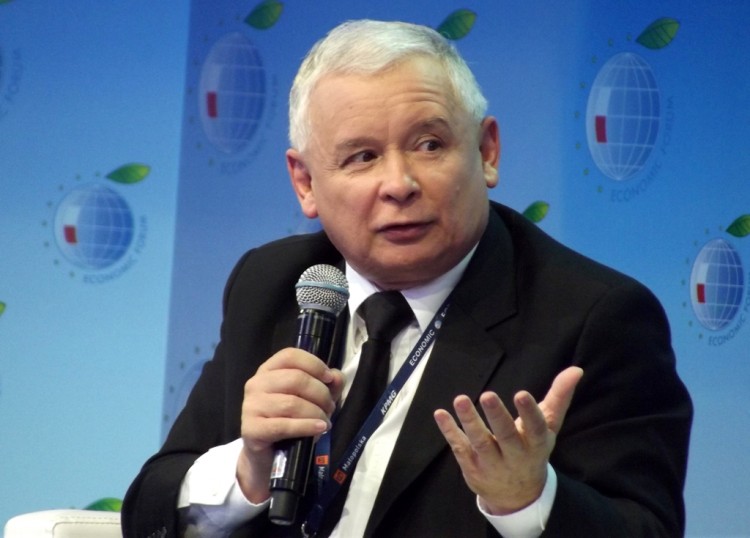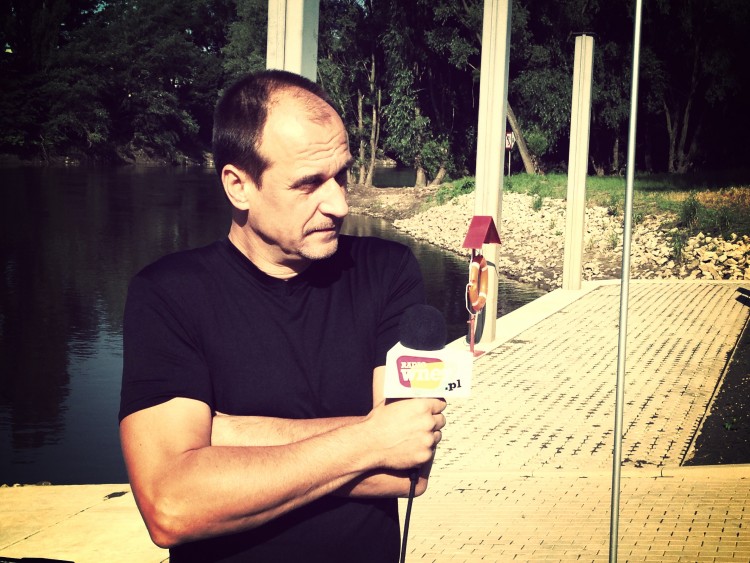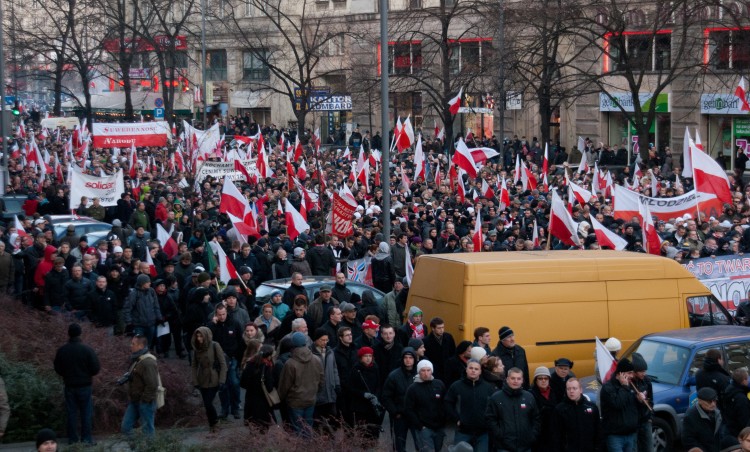The new parliament in Poland resembles in its makeup the one in Hungary, almost completely dominated by right-wing political parties. The Law and Justice party beat the Civic Platform party, with 37.8 percent of the vote, against 24.9 percent. The victory of Law and Justice was not surprising. It shows again that good economic growth is not enough if it goes together with sustained inequalities, regional unevenness, and stagnation for many. For young people, blue-collar workers, and low-paid service employees, the benefits of growth remain overshadowed by the reproduction of underpaid and unregistered employment, sharp increases in temporary “junk” contracts, and the feeling of economic exclusion.
Addressing these concerns, Law and Justice not only promised many welfare benefits, such as monthly payments of 100 euro for a child, starting with the second one; going back to the previous retirement age; and raising tax allowances from 730 euro to 2,000 euro. The party also boasted its determination to fight against low-paid and precarious employment, in cooperation with trade unions. The party made many people believe that Poland is bedraggled, weak, dependent on foreign capital, and governed by a network of liberal elites who despise “normal people” in favor of their European and transnational interests. Opposing European liberalism and multicultural politics, the party emphasized the need to defend Catholic values, the Polish traditional family, national media, and the national education system. In the context of the current refugee crisis, Law and Justice leaderships also refused to accept the quota system for refugees as an imposition by the European Union. Thus speaking to the fears of Poles, it managed to win a sufficient number of votes to form a government on its own without any need for coalition partners—this, for the first time in Poland since 1989.
Combined with the victory of Andrzej Duda, the Law and Justice candidate in the May 2015 presidential elections, the results give the party of Jarosław Kaczyński an unprecedented power to introduce major reforms not only in the economic sphere but also culture and education. The plans include reforms in the public media—motivated by an aspiration to change them into national media—and in education, which involves abolishing gymnasiums and placing greater emphasis on patriotic content. Educational reforms also plan to go back to five-year-long master’s studies, making bachelor’s studies optional and exceptional, and thus effectively backing out of the Bologna Process that intends to loosely unify European higher education systems. Earlier flagship projects, such as further restrictions to the already very restrictive abortion law and the ban on public financing for in vitro fertilization, were largely left out from the election campaign but reappeared in the agenda almost immediately after the elections.

Jarosław Kaczyński, chairman and cofounder of the Law and Justice Party, at the 23rd Economic Forum in Krynicaj, Poland (Photo: Plotr Drablk, 2013, CC BY-SA-2.0)
Another crucial result of the elections is the fact that the Democratic Left Alliance, which took part in the elections as the United Left (a coalition of the Democratic Left Alliance, the Greens, Your Movement, the Polish Socialist Party, and Labour United) did not even get into the parliament. According to some commentators, Civic Platform and the new liberal party, Modern (7.6 percent), might take over the role of the Left with regards to secularism and culture, such as in education and women’s and minorities’ rights. However, no major turn in their neoliberal economic programs can be expected. Indeed, Civic Platform’s slogan of “going back to the roots,” which appeared in media comments following its electoral defeat, can be interpreted as a wish to return to more hard-line economic liberalism rather than to continue the effort to put up some social–democratic cosmetics in order to compete with the now strongly established pro-welfare state tendencies of the Right (see, e.g., Kalb 2009; Kalb and Halmai 2011).
The whole situation illustrates not only the weakness of the Democratic Left Alliance but also a more general wave of right-wing political sensibilities in Polish society, mostly among young people. Many right-wing publicists presented the Democratic Left Alliance’s failure a sign of “the end of post-socialism in Poland,” suggesting that socialism had now finally died. However, there is also a newly established left-wing party called Together. It involves students, teachers, academics, artists, and local activists, who all present themselves as a voice of the precariat. It gained 3.62 percent of the votes and, as a result, will now be financed from the state budget until the next elections. It remains to be seen if Together can be the beginning of a new Left in Poland.
The Right turn in the new parliament is further deepened by the success of Paweł Kukiz’s club, Kukiz’15 (8.81 percent). Kukiz, a rock musician, has built his movement mostly on anti-elite slogans. He has refused to present any political program except for the demand to introduce a single-winner voting system in parliamentary elections, which he defined as a tool to fight “partocracy.” After his surprising success in the 2015 presidential election (20.8 percent of votes), he decided to establish a new movement. Crucially, he opened his party lists for different representatives from different parties and milieus, including, importantly for the right-wing youth vote, the National Movement.

Paweł Kukiz, founder of the Kukiz’15 right-wing political party and a 2015 presidential candidate (Photo: Media WNET, 2013, CC BY-SA-2.0)
The National Movement was established in 2014 by members of the two main Polish nationalist organizations, the All-Polish Youth and the National Radical Camp. It was officially registered as a political party in February 2015 and is known mostly because of the Independence Marches on November 11, when Poland’s Independence Day is celebrated. In previous years, the marches were mostly used to mobilize nationalist groups against the liberal government. After attracting 10,000 people in 2010, they reached an impressive 70,000 in 2014. In 2015, the march in Warsaw was organized under the slogan “Poland for Poles, Poles for Poland!” Even though it is hard to estimate the membership of radical nationalist organizations due to the lack of reliable statistics, the fast increasing number of participants in the Independence Marches since 2010 clearly indicates their potential for mobilization. They involve heterogeneous youth milieus: students, university graduates, soccer fans. It is worth noting that the movement has changed in the past years: fewer skinheads, more women. It is also very much present in, and driven by, social media, both via well-attended fan pages and through the high visibility of far-right commentators in various Internet platforms.
This successful extra-parliamentary mobilization has not translated into any significant National Movement wins in previous elections (1.4 percent in the 2014 European Parliament election, 1.57 percent in 2015 council elections, 0.52 percent in the 2015 presidential elections). Now some of its representatives have decided to join Kukiz’s club, declaring, “What is common for us and constitutes the basics of our work is a critical diagnosis of the political and economic situation, as well as the demand for cleansing the public life from a liberal party clique, repolonising the economy, and resisting the financial drain of our state.” This decision of some led to splits. The National Radical Camp refused to cooperate with Kukiz and declared its withdrawal from the National Movement in August 2015. We can now observe the proliferation of internal conflicts and mutual accusations within the right-wing youth movements. Some accuse their former colleagues who joined forces with Kukiz of betraying their ideals on behalf of their own political careers. As they state, there were too many different milieus on the Kukiz lists, and being with them in the same committee was unacceptable.

Poland’s Independence March, Warsaw, 2011 (Photo: Adam Kliczek, CC BY-SA-3.0)
Interestingly, all candidates of the National Movement were asked to sign a “national contract” in order to get the backing from their party. According to the contract, candidates declared, among other things, their support for sharpening immigration politics and maintaining the nation’s cultural and ethnic cohesion; making Poland independent of the EU; refusing entry into the euro; tightening relations with other Central and Eastern Europe actors; opening for China, Turkey, and Belarus; halting financial support from the state for milieus and initiatives that attack Polish historical, cultural, and religious heritage; refusing Jews’ financial claims; and supporting actions aiming at militarizing the nation (e.g., common access to guns, more shooting galleries, training courses organized by the army).
Following the election results, there will be eight MPs connected with the National Movement in the new parliament. However, the movement’s future seems to be unsure. Since one of the newly elected MPs is also its chairman, the organization can constitute a kind of social movement backup for nationalist politicians, which may be divisive. Additionally, there are well-established radical nationalist organizations that do not cooperate with the National Movement, such as the National Radical Camp and the National Rebirth of Poland. Despite the fact that all of the mentioned organizations imagine their roots in the Polish national movements of the interwar period, in particular Roman Dmowski’s works, the internal conflicts make their cooperation almost impossible. While the National Radical Camp and the All-Polish Youth, both relatively strongly linked to student milieus, have some common initiatives, the National Rebirth of Poland, slightly more embedded in radical soccer fans’ circles, stays far away from them. Importantly, all three organizations are more anchored in large and medium-sized cities rather than rural areas.
The future will show how Polish nationalists will adjust to a situation where the nationalist Right actually rules. Now, even though they seem to have a lot of common with Law and Justice, the latter is still considered a part of the corrupt system. Moreover, some nationalists accuse Law and Justice of betraying Poland by signing the Lisbon Treaty in 2007.
How will the rise of the Polish Right further influence the political discourse in the country? Will the right-wing dominance in parliament change the mobilization and discourse of extra-parliamentary nationalist movements? While Kaczyński openly expresses his fascination with Victor Orbán’s politics, the National Movement is likely to follow the path of Jobbik, the Movement for a Better Hungary. The Hungarian far-right party was among the first to congratulate its newly elected representatives in the Polish parliament. However, taking into consideration that Jobbik is now the second political party in Hungary and the National Movement was only to get a handful of people into parliament, it is hard to believe such a scenario. Another option would be a kind of selective inclusion of the National Movement MPs into the mainstream Right and their defamation by the extra-parliamentary radical nationalist organizations.
What is certain is that tensions within the Polish Right are likely to grow in the future. The Law and Justice agenda will be confronted by the reality of Poland’s budget and its international obligations. In addition, a continued strong representation of (neo)liberals in parliament, the power of the private mass media, and the presence of a new Left in the public sphere with strong roots in the academic environment present additional challenges to the right-wing hegemony in the country. It should also be remembered that with the electoral turnout just slightly exceeding 50 percent, the public legitimacy of Law and Justice as a ruling force is well below Orbán’s Fidesz party. Thus, while the Polish right is stronger now than at any time after 1989, the scenario of the “Orbanization” of Poland might still be some time off.
Justyna Kajta is a PhD candidate at the Institute of Sociology at the University of Wrocław. Her research interests concern discourse analysis, social movements, nationalism, and social and political transformation in Central and Eastern Europe.
Dr. Adam Mrozowicki is a lecturer at the Institute of Sociology at the University of Wrocław. His research focuses on labor movements and comparative employment relations in Central and Eastern Europe.
References
Kalb, Don. 2009. Conversations with a Polish populist: Tracing hidden histories of globalization, class, and dispossession in postsocialism (and beyond). American Ethnologist 36(2).
Kalb, Don, and Gábor Halmai, eds. 2011. Headlines of nation, subtexts of class: Working class populism and the return of the repressed in neoliberal Europe. Oxford and New York: Berghahn Books.
Cite as: Kajta, Justyna, and Adam Mrozowicki. 2015. “The new Polish parliament: Between the Right and the radical Right.” FocaalBlog. 19 November. www.focaalblog.com/2015/11/19/justyna-kajta-adam-mrozowicki-the-new-polish-parliament-between-the-right-and-the-radical-right.